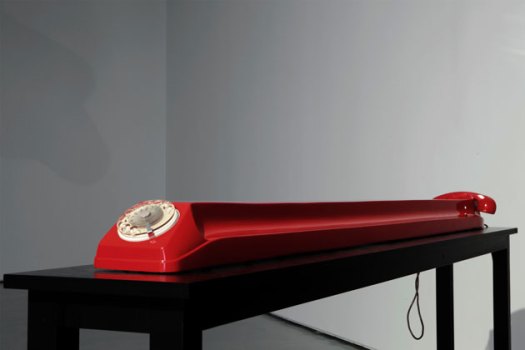“The Uncle Phone” by Pors & Rao. Photo by Jorge Martín Muñoz.
At TEDGlobal 2011, Aparna Rao showed a glimpse of the high-tech, often humorous art she creates with collaborator Søren Pors. We followed up with the TED Fellow to talk about her artistic approach and projects in progress.
You use some pretty sophisticated technology to bring your creations to life. What’s the most challenging thing you’ve learned, technologically, for a project?
The first thing I should mention is neither Søren nor I have any engineering background, neither is the technology we have used so far very cutting-edge. Most of it existed at least 50 years ago, but that does not make it less challenging to work with. The most important thing for us has been finding the right mentor and collaborators. A very experienced hands-on robotics scientist is mentoring us, and this helps us foresee technical challenges at the outset of a project.
Even though the technologies we use are simple, combining them together with the added constraints of time, budget, customized requirements, etc. usually adds several layers of complexity. We have learned most technical challenges can be overcome, but not without perseverance and belief that it is somehow possible — that we will somehow unearth the resources or find a new perspective to help us unravel the solution. It is always a struggle on some level, but so far we have never given up, even if it means years and years of trying. When we finally crack it, of course, the challenge seems fully worthwhile.
While your artwork is tech-rich, it invites (and often requires) human interaction. What interests you about the interplay between art, people and technology?
We are really curious to see how other people respond to the work — what behavioral mechanisms and thoughts they trigger. It is quite satisfying if other people connect to something we also feel deeply connected to, but of course our personal investment in creating these objects has more selfish motives. Our interest lies mostly in the discovery of the thing or “being” that is inside our head and in creating it as accurately as possible. That is what we obsess about. Technology or ideas of responsiveness are never starting points for us. On the contrary, we often try to limit the use of technology and interaction, and to simplify it as much as possible. We find technology quite tricky to work with; without firm or nuanced control, it can easily distract from the essence of the artwork.
Why do you use humor in your art, and for a given project, how do you decide where to add humor?
Many of the things we do have some kind of humorous side, and we really enjoy that. But again, humor is not a deliberate ingredient in our work. We think of it as one of many facets we hope our works can encapsulate. We like to think different ways of experiencing can co-exist in the same object, and one of them is humor. We want the objects we make to somehow posses the same kind of complexity we experience in the world, but in a very simple form.
What are you working on right now?
We have received a commission from the Metamatic Research Initiative, a nonprofit art foundation in Amsterdam, to do a project we have been wanting to do for a long time. It explores the idea of a small mischievous creature having invaded a TV set, and how that affects the broadcast and the viewer. It is a kind of audiovisual trick-or-treat. We also just completed putting together material for our website (porsandrao.com); it is currently up.

Comments